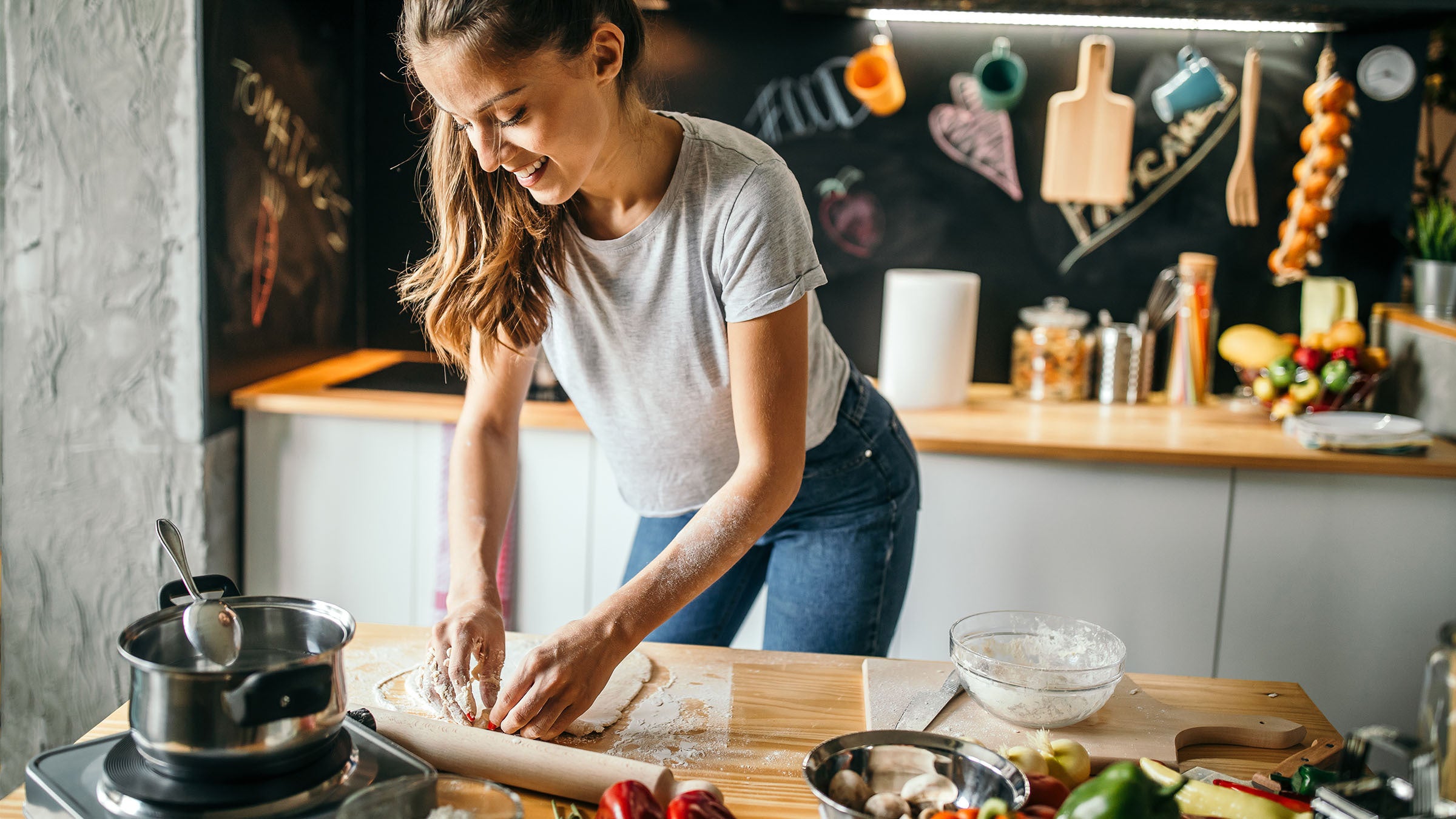Published March 12, 2021 11:31AM
Kitchen Solutions for Cooks in Small Spaces
10 tips for fearless cooking, even in the tightest of spaces.

Cramped, cluttered and in desperate need of a little extra elbow room? Optimize space, boost efficiency and go boldly into your small cooking space, with these simple tips for the tiniest of kitchens.
- Rethink appliances. Indoor grills, food processors and other giant appliances monopolize space, and if they’re not living on the counter, they’re hogging real estate in your already-cramped cabinets. Get rid of that tortilla maker, bread machine, anything you don’t use at least three times a week and look for smaller versions: a mini food processor, a hand mixer instead of that bulky standing mixer. Opt for multi-tasking workhorses; a multi-cooker takes the place of a crock pot, pressure cooker, rice steamer and more. And a Vitamix does more than blend; use it for chopping, grinding or whipping (bonus: its vertical orientation claims minimal counter space). Also consider replacing or opting for mini versions of appliances instead of full-size if you don’t require, say, a 6-quart food processor.
- Put walls to work. No matter how small, your kitchen has at least one wall; maximize that super-efficient vertical space. A wall-mounted spice rack declutters pantry shelves, keep spices within convenient reach. Install adjustable hooks on walls for lightweight items like spoons or measuring cups. And wall-mounted pot rack with hangers frees up a ton of cabinet space; or opt for a ceiling-mounted version for hanging saucepans and skillets.
- Curate cookware. Clear out that hodgepodge collection of random pots and pans, and be selective with basics: a 2-quart sauce pan, a 4- or 6-quart stock pot and a good skillet. A deep sauté pan with tall sides can be used for frying, braising, poaching and making sauces. An enameled Dutch oven does double-duty stove top and in the oven, for stews, casseroles, even baking. And that multi-cooker can replace a stock pot or vegetable steamer.
- Streamline knives. Sharp, cutty things are fun, but how many knives do you really need? Pack up the tomato slicer, cheese knife and Chinese meat cleaver, and stick to the basics: an 8-inch chef’s knife, a bread knife, a utility knife and a paring knife. Bulky knife blocks hog kitchen space; opt for a magnetic bar to store knives safely, without dulling (and free up drawer space too).
- Stretch prep space. Tiny kitchens have tiny counters; expand your prep space with simple, inexpensive options. Set an oversized cutting board on a (cool) stovetop, or look for boards designed to fit over the sink; one with a built-in colander adds an extra element of efficiency. A drop-down table installed on a wall (there’s that vertical space thing again) adds an extra few feet of prep space and can be folded up when you’re not using it. Or invest in a rolling kitchen cart with shelves for instant counters; look for a collapsible version you can tuck in a corner when you’re not using it.
- Take inventory. Give your pantry a once-over before you head to the store, to offset pantry chaos (and minimize food waste). Plan meals around what you have on hand, using older ingredients first, and do a regular inventory. Compost stale crackers and expired spices; toss old condiment packets; bag up canned goods you’ll never eat and donate them to the food pantry. Group similar items together, and consolidate; combine those two opened bags of French roast coffee into a Mason jar.
- Look for hidden spaces. Even the tiniest kitchen has sneaky little spaces; get creative with those hidden storage opps. Stash racks on top of kitchen cabinets to organize baking sheets and casseroles. Install paper towel holders, wine racks, hooks for hanging coffee mugs under kitchen cabinets. And put all the open real estate on your fridge to work: install magnetic racks on the side for spices, stick on magnetic hooks for towels, add a heavy-duty magnetic bar for storing knives. Here are some of our favorite tools for decluttering your kitchen.
- Make baking orderly. Cookie and cake-making wares take up more space than they should (and you probably don’t use most of them). What you need: a set of mixing bowls (look for nesting bowls to minimize storage footprint), a set of nesting measuring cups, a 2-cup Pyrex cup for liquids, measuring spoons, a rubber spatula and a rolling pin. Pack up the fondant tools and macaron mats, and keep only the essentials.
- Declutter drawers. Kitchen drawers are clutter magnets. Box up mango pitters, potato mashers and all the random things you don’t regularly use and stow them in a closet. Must-haves: an instant read thermometer, wooden spoon, spatula, whisk and can opener. Keep multi-use items like cheese graters (use them to zest citrus and grate ginger), and slip a cutlery tray into drawers to organize essentials. And about that junk drawer filled with rubber bands, broken pens and used batteries: be ruthless about tossing what you don’t need.
- Uplevel your efficiency. Before you start cooking, make a plan: stagger cooking times to optimize counter and cooktop space. Start the pasta sauce, then let it simmer while you’re prepping salad. Think ahead, so you’re not scrambling for a place to put that blazing-hot pan of biscuits. Make double portions of bean, soups, casseroles, then freeze for easy weekday meals. And clean as you go, since stuff piles up fast in little kitchens. Store ingredients immediately after you’re done with them, rinse and reuse stirring spoons and spatulas, transfer pots and spoons to the dishwasher instead of letting them accumulate in the sink. Bonus: cleanup after cooking will be a breeze.
Related content: